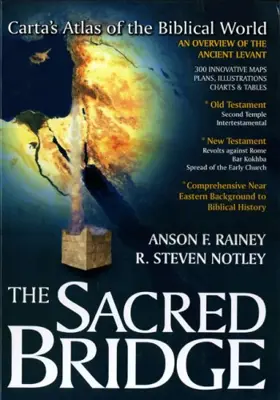

The Sacred Bridge: Carta's Atlas of the Biblical World
Pages
448
Publisher
Carta
Published
2005
ISBN-13
9789652205292
To meet the need for clear and accurate information, Professors Anson F. Rainey and R. Steven Notley have now come forward with an atlas that traces the course of Near Eastern history from the Chalcolithic Age (c. 3500 BCE) to the defeat of Bar Kochba's fighters and their retreat to the caves east of En-gedi. The product of close cooperation between two distinguished scholars of world renown and the knowledgeable and experienced staff of Carta, Jerusalem, this Atlas provides 300 state-of-the-art maps to show as far as possible in terms of modern knowledge the changes and historical processes that affected the lands of the Bible. Included are all historical and biblical episodes that can be depicted cartographically—migrations and settlements, battles and conquests, the location and detailed movement of individual historical and biblical characters. In addition, The Sacred Bridge—Carta's Atlas of the Biblical World draws on information from all known ancient sources-Egyptian, Assyrian, Greek, Roman and others—to reveal trade routes, economic determinants, and the development of international relations. Maps, many of them never before attempted, are presented chronologically, with extensive interpretive texts alongside. Finds, tools, artifacts, inscriptions and other documents from each period also appear in conjunction with the maps. The ultimate usefulness of any complex reference work depends on its index and its bibliography, and The Sacred Bridge—Carta's Atlas of the Biblical World provides everything that could be asked for in the way of organized assistance to the reader. Each person or site can be located. An invaluable chronological table correlates historical activity in the East (Mesopotamia and Anatolia), the southern Levant, Egypt, and the Greco-Roman West from 2800 BCE to the second century CE. The superb reference sections contain every article, book or document consulted. The extensive index contains every place name that has been mapped and, in addition, names that still defy exact location but can be shown in relation to specific biblical episodes. New Testament geography, especially that of the Gospels, is interpreted in the light of the new understanding resulting from such discoveries as the Dead Sea Scrolls (e.g., the wider use of Hebrew as a social and religious vehicle than heretofore acknowledged). These refreshing insights serve to define geographical terms used in the New Testament and trace their origin. Documents are presented in their original languages and transcribed or translated into English. A special feature of this atlas is the insertion of these texts and their meaning within the narrative proper.
Reviews
Outstanding in every way. The reference work par excellence. See my full (in-depth, with pictures) review at the link.
[Full Review]
This very impressive volume is lavishly illustrated with maps, photographs, and charts. It is the successor to The Macmillan Bible Atlas, later updated and issued under the title The Carta Bible Atlas. The present work contains twenty-five chapters covering the history of the Levant from the Early Bronze Age (fourth millennium B.C.E.) to the Bar Kokhba Revolt (132–135 C.E.). The first three chapters lay the ground for what is to come. Chapter 1, “Dimensions and Disciplines,” presents the discipline of historical geography with special emphasis on physical geography, historical philology, and toponymy. It also discusses briefly the field of archaeology and its contributions to the understanding of the ancient Near East. Chapter 2, “The Ancient World View,” examines some examples “of the world view expressed by major cultural elements in the Ancient Near East, including the Israelites” (25). Chapter 3, “The Land Bridge,” takes a look at the eastern Mediterranean littoral as described in ancient sources and depicts its topography and climate, two very important historical and cultural factors. Starting with chapter 4, “The Dawn of History: Early and Intermediate Bronze Age,” each historical period and some major historical events are described in detail in separate chapters. These include: “Amurrite Dominance: Middle Bronze Age” (ch. 5); “Conquest and Confrontation: Late Bronze Age I” (ch. 6); “The Amarna Age: Late Bronze Age II” (ch. 7); “The Ramesside Age: Late Bronze Age III” (ch. 8); “Crisis and Transition: Twelfth Century BCE” (ch. 9); “Survival and Renewal: Eleventh Century BCE” (ch.
[Full Review]


